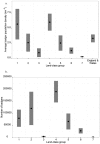Abundance of badgers (Meles meles) in England and Wales
- PMID: 28325904
- PMCID: PMC5428277
- DOI: 10.1038/s41598-017-00378-3
Abundance of badgers (Meles meles) in England and Wales
Abstract
The European badger (Meles meles) is of considerable interest in the UK as it is both a protected species and the main wildlife reservoir for bovine tuberculosis infection in cattle. While there have been three national badger surveys in the 1980s, 1990s and 2011-13, using the number of badger main setts as a proxy for the abundance of badger social groups, none has combined contemporary data on social group size at landscape and national scales. We estimated social group size by genotyping hair samples collected at 120 main setts across England and Wales and employing a capture-mark-recapture method based on genotypes. The estimated mean social group size in England and Wales was 6.74 (±0.63) badgers. There was considerable variation in badger social group size among Land Class Groups (LCGs), with a low of 2.67 in LCG3 and a high of 7.92 in LCG4. Combining these results with the recent Badger Sett Survey of England and Wales, we estimate there are approximately 485,000 badgers (95% confidence intervals 391,000-581,000) in England and Wales. Although direct comparison with previous estimates is not ideal owing to methodological differences, our results are consistent with a marked increase in the badger population of England and Wales since the 1980s.
Conflict of interest statement
The authors declare that they have no competing interests.
Figures
Similar articles
-
Density and abundance of badger social groups in England and Wales in 2011-2013.Sci Rep. 2014 Jan 23;4:3809. doi: 10.1038/srep03809. Sci Rep. 2014. PMID: 24457532 Free PMC article.
-
Estimating the risk of cattle exposure to tuberculosis posed by wild deer relative to badgers in England and Wales.J Wildl Dis. 2009 Oct;45(4):1104-20. doi: 10.7589/0090-3558-45.4.1104. J Wildl Dis. 2009. PMID: 19901384
-
Behaviour of European badgers and non-target species towards candidate baits for oral delivery of a tuberculosis vaccine.Prev Vet Med. 2016 Dec 1;135:95-101. doi: 10.1016/j.prevetmed.2016.11.007. Epub 2016 Nov 14. Prev Vet Med. 2016. PMID: 27931935
-
Mycobacterium bovis infection in the Eurasian badger (Meles meles): the disease, pathogenesis, epidemiology and control.J Comp Pathol. 2011 Jan;144(1):1-24. doi: 10.1016/j.jcpa.2010.10.003. Epub 2010 Dec 4. J Comp Pathol. 2011. PMID: 21131004 Review.
-
Wildlife disease ecology from the individual to the population: Insights from a long-term study of a naturally infected European badger population.J Anim Ecol. 2018 Jan;87(1):101-112. doi: 10.1111/1365-2656.12743. Epub 2017 Sep 28. J Anim Ecol. 2018. PMID: 28815647 Review.
Cited by
-
Impact of test, vaccinate or remove protocol on home ranges and nightly movements of badgers a medium density population.Sci Rep. 2023 Feb 14;13(1):2592. doi: 10.1038/s41598-023-28620-1. Sci Rep. 2023. PMID: 36788237 Free PMC article.
-
Push and pull factors driving movement in a social mammal: context dependent behavioral plasticity at the landscape scale.Curr Zool. 2019 Oct;65(5):517-525. doi: 10.1093/cz/zoy081. Epub 2018 Nov 28. Curr Zool. 2019. PMID: 31616482 Free PMC article.
-
Bait uptake by wild badgers and its implications for oral vaccination against tuberculosis.PLoS One. 2018 Nov 9;13(11):e0206136. doi: 10.1371/journal.pone.0206136. eCollection 2018. PLoS One. 2018. PMID: 30412584 Free PMC article.
-
Assessing effects from four years of industry-led badger culling in England on the incidence of bovine tuberculosis in cattle, 2013-2017.Sci Rep. 2019 Oct 11;9(1):14666. doi: 10.1038/s41598-019-49957-6. Sci Rep. 2019. PMID: 31604960 Free PMC article.
-
Soil δ13C and δ15N baselines clarify biogeographic heterogeneity in isotopic discrimination of European badgers (Meles meles).Sci Rep. 2022 Jan 7;12(1):200. doi: 10.1038/s41598-021-04011-2. Sci Rep. 2022. PMID: 34997035 Free PMC article.
References
-
- Moore N, et al. Survey of badger Meles meles damage to agriculture in England and Wales. Journal of Applied Ecology. 1999;36:974–988. doi: 10.1046/j.1365-2664.1999.00454.x. - DOI
-
- Delahay RJ, et al. Managing conflict between humans and wildlife: trends in licensed operations to resolve problems with badgers Meles meles in England. Mammal Review. 2009;39:53–56. doi: 10.1111/j.1365-2907.2008.00135.x. - DOI
-
- Roper, T. Badger. Harper Collins UK (2010).
-
- Cresswell, P., Harris, S. & Jefferies, D. J. The history, distribution, status and habitat requirements of the badger in Britain. Nature Conservancy Council, Peterborough, UK (1990).
Publication types
MeSH terms
Substances
LinkOut - more resources
Full Text Sources
Other Literature Sources



